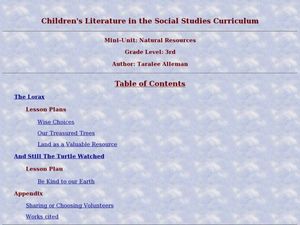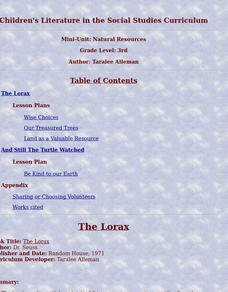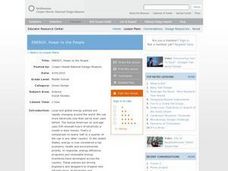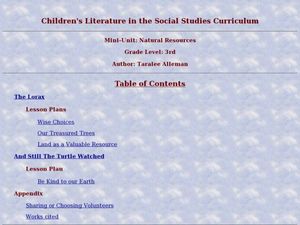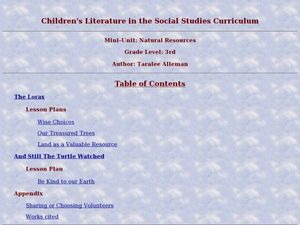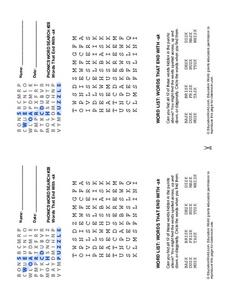Curated OER
Can You Do It?
Middle schoolers create a simple machine to help with the design of the traditional can opener. In this simple machines lesson plan, students analyze the can opener, and use the design process to solve problems.
Curated OER
America's Favorite Landmarks
Students research using Google Earth a variety of websites to explore America's most prominent and famous buildings. They then compare and contrast architectural styles and write a position paper defending or arguing against their chosen...
Curated OER
Biomimicry, Nature: Architecture of the Future
Students explore the relationship between nature and architecture. In this cross curriculum history, culture, and architecture lesson, students observe and discuss structures visible in nature. Students view websites in which Native...
Curated OER
A Tough Nut to Crack
Sixth graders explore agriculture by examining world geography. In this pecan cultivation lesson plan, 6th graders identify the history of the famous nut and the impact it has on the U.S. economy, diet and human body. Students define...
Curated OER
Conservation at a Crossroads Lesson 1: What Is Conservation and Why Does It Matter?
High schoolers explore the concept of conservation. In this conservation instructional activity, students read articles and primary documents about the Conservation Movement in the United States and compare the movement to today's...
Curated OER
The Lorax
Third graders identify environmental problems. In this natural resources lesson plan students participate in several activities that support critical thinking about the environment and natural resources. The students write, list, and...
Curated OER
Mini-Unit: Natural Resources
Students explore how their choices affect others. In this character development and ecology lesson, students debate choice-making issues. Students listen to The Lorax by Dr. Seuss and identify choices the characters made about tree...
Curated OER
Land as a Valuable Resource
Students investigate why the soil is important to our lives. In this natural resources lesson, students have a farmer as a guest speaker. Students begin to understand how farmers use and protect our natural resource. Students write...
Curated OER
The Mayflower Compact
Eighth graders investigate historical documents of the United States by reading the Mayflower Compact. In this U.S. History lesson, 8th graders analyze the wording of the original Mayflower Compact of the first U.S. settlers and...
Curated OER
Ancient Roman Monuments and Timeline
While a terrific idea, this lesson in which learners create a timeline showing the date that a variety of buildings and monuments were built in Ancient Rome, requires resources teachers may not have. It requires the use of a Smartboard,...
Curated OER
Energy: Power to the People
Students explore the concept of renewable energy. In this green design lesson, students research local energy issues facing their community and create policies to address the issues.
Curated OER
Every Object Tells a Story
High schoolers read the story behind objects in the Cooper-Hewitt National Design Museum and create a story about an object in the exhibit. In this design lesson, students explore the "Design for the Other 90%" exhibition and create a...
Curated OER
Coast-to-Coast Book Design-Part 3: Brainstorming the Book
Middle schoolers examine the process of designing a book and identify the steps necessary to publish a book. In small groups they analyze ABC books, and discuss the similarities and differences between the books. Students then brainstorm...
Curated OER
Use or Make a Table
In this make a table worksheet, students read real world questions and write an equation to match the equation. Next, they solve the equation. This one-page worksheet contains two problems.
Curated OER
Who is the President Now?
High schoolers discover the presidents of the United States using digital tools. In life skills lesson, students use PowerPoint and SMART Board technology to match presidents of the United States to their photographs.
Curated OER
The Civil War in Historical Fiction and Historical Accounts
Eighth graders examine life during the Civil War through various readings. They compare and contrast a novel they read in class to one they chose on the subject. They work together as a class to produce a newspaper displaying the...
Curated OER
The Lorax
Third graders identify and list five problems presented in The Lorax by Dr. Seuss. They relate these problems to current environmental issues and debate how to make a difference then participate in different activities to improve their...
Curated OER
Our Treasured Trees
Young scholars discuss natural resources and renewable resources with trees being considered renewable resources which need special attention. In this Earth science lesson, students write a list of reasons for why it would be good to...
Curated OER
And Still The Turtle Watched
Third graders discuss ways to be kind to the Earth. In this conservation lesson plan, 3rd graders listen to the story And Still The Turtle Watched by Sheila MacGill-Callalhan. They compare how the early people treated the Earth to how we...
Curated OER
Be Kind to our Earth
Students make a list of ideas on ways we can take care of our Earth and complete a class project planning sheet where they problem solve to help save the Earth. In this Earth lesson plan, students also play a conservation charades game.
Curated OER
Setting Goals with Benjamin Franklin
Students discuss historical accounts and accomplishments of "Benjamin Franklin" which exemplify good character traits. They create a display of paper keys which describe these traits. They relate these traits to their future goals and...
Education World
Phonics Word Search: -sk
In this phonics word search worksheet, students locate and mark the 12 words in the word bank that end with -sk within the word puzzle.
Education World
Phonics Word Search: -at
In this phonics word search worksheet, students locate and mark the 12 words in the word bank that end with -at within the word puzzle.
Curated OER
Biomimicry: Working Together, Cooperative Design
Students explore the concept of biomimicry. In this cooperative design instructional activity, students consider how cooperation is connected to nature and then collaborate to create their own cooperative designs for the future.







